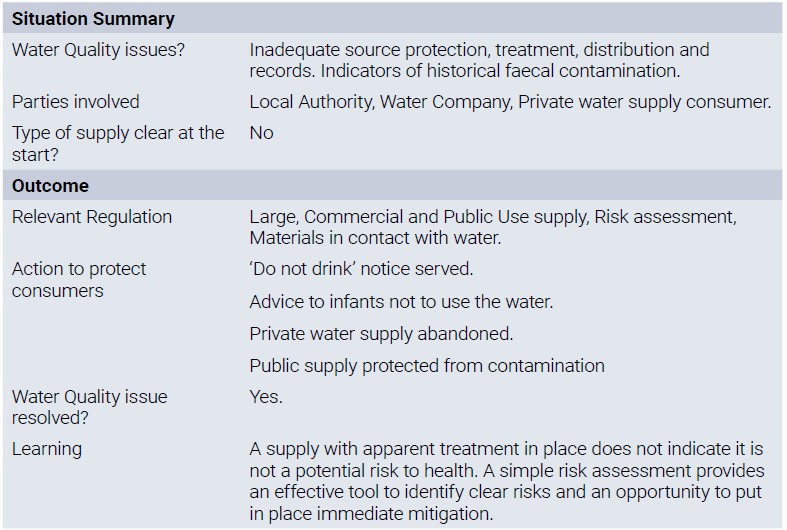Improvements at a large supply (Regulation 9)

Introduction
This case study concerns a large spring fed supply, which is provided as part of a commercial activity. This feeds a village with a resident population of 200 which increases by 499 when a private party venue uses the supply.
The source comprises several springs with collection chambers of differing construction materials, conditions. All but one of these springs feed into a main reservoir via a brick-built chamber and a raised limestone filter bed. The remaining spring enters the reservoir at a different point and is passed through two barrels filled with limestone. The limestone filter bed was installed to provide sediment filtration and pH adjustment. It comprises of a slotted slate floor with three sizes of limestone chips on top. There was no turbidity or pH monitoring prior to or after the limestone bed. The reservoir has a capacity of 60m3 and is uncovered, although it is housed in a brick building. The supply produces 40m3/day which is treated by chlorine dosing and pH correction before being pumped into several tanks to supply points around the village.
The supply had become increasingly unreliable because of leaking supply pipes, periodic low rainfall and an increasing demand arising from growing numbers using the supply. Alternative supplies had been explored by the consumers with the local water company but ruled out on cost grounds. This is an opportunity missed to secure a safe and secure water supply to a substantial population which would benefit public health.

A risk assessment carried out by the local authority identified springs that were not in use in the short term being ‘plugged’ in a below ground chamber. This creates an obvious opportunity for stagnant water to pool over the source (Figure 1) creating a possible route of ingress into the collection point.
A sample taken in October contained coliforms, Clostridium perfringens and a pH lower than the regulatory minimum. The presence of Clostridium perfringens indicate historical faecal contamination and a potential risk to health. In response the local authority served a notice, requiring consumers to boil the water, and programmed a visit for the next month to complete a site risk assessment.
The subsequent risk assessment identified a number of deficiencies with both the treatment systems and the network maintenance which rightly led to the issue of an amended notice. Most notable was the use of a chemical for chlorination which was not approved. Products which are not approved for use for drinking water may be ineffective or contain impurities (other trace chemicals) not suitable for consumption. The Notice therefore required:
- Installation of an automated chlorine dosing linked to flow rates and pH levels, including a standby arrangement should one dosing unit fail
- Routine chlorine monitoring programme from the outlet of the reservoir and throughout the distribution system.
- Installation of pH correction and monitoring equipment.
- That maintenance or testing records should be kept confirming work being carried out to keep the supply safe and secure for drinking.
- Abandonment of high risk, sedimented springs.
Additional recommendations for improvements were identified during the risk assessment such as covering the storage reservoir to prevent ingress, ensuring adequate contact time for disinfection to be effective, and a review of the selection of springs for use.
This reflects a proportionate approach to the regulations, in line with the risk assessment tool approach which requires high and very high risks to be addressed in the first instance, but documents medium risks for further action in the future.
Together with the local authority, the Inspectorate visited the supply to assess the work undertaken to comply with the notice.
The chlorine dosing system was found to be working correctly, and pH correction was now being undertaken via an automatically controlled dosing system.


The supply owners produced a detailed plan of the distribution system (Figure 4). This is essential for the purposes of the local authority to carry out a risk assessment and necessary to facilitate potential repair and maintenance work. Where parts of the supply are unknown and cannot be inspected this should be considered a hazard and assessed accordingly. In many private water supplies, there are no maps or schematic diagrams of assets showing their site location, and or position within the supply configuration. This will flag as a very high-risk hazard when captured on the risk assessment tool. Water pipes underground are not straight forward to locate, so any chance to update a schematic of the supply system should be taken. When any mains repair takes place, a record should be made documenting where it was located, what size and material the pipe was, its condition and when the repair occurred. In addition, the location of valves, washouts, take off points and hydrants should also be noted.
Additionally, introduced was a logbook to demonstrate that records of on-site chlorine readings at a range of representative points to verify that the residual disinfectant was persisting to the end of the network.

It should not be assumed that since there appeared to be a treatment system in place that this is either suitable for the source, appropriate in its use or sufficient in its effectiveness in controlling risks.
This case study shows the benefit of the risk-based regulations. A relatively simple site assessment effected a short-term boil water notice to immediately secure public health to a small but significant population. Subsequently to this, the risk assessment identified deficiencies in control, operation and monitoring of the system, which supported a medium-term action plan to mitigate risks proactively in controlling collection, chlorination, monitoring and distribution. However, this will not resolve the long-term issue of insufficiency which is an issue that often affects private water supplies. In this case the situation may well become worse as resources become scarce.
Local authorities have an obligation to proactively bring about improvements to supplies where a risk to health is identified by using enforcement powers.
